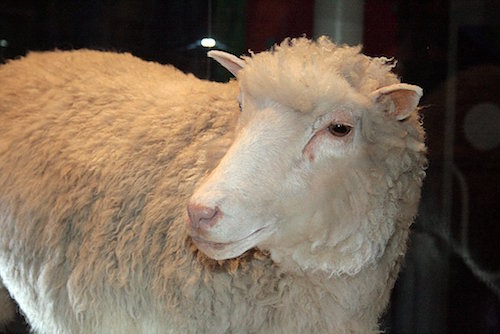 Culture & Ethics
Culture & Ethics
Dolly Clones Pave the Way for Human Cloning

Apparently clones of the same dead sheep from which Dolly was manufactured are in good health and aging normally. From the Live Science story:
Four cloned sheep that are genetically identical to Dolly, the first cloned mammal, are still healthy even in old age, a new study found. The four sheep, which were derived from the same batch of cells as Dolly and could be considered her clone “sisters,” have just reached their 9th birthday, which is equivalent to age 70 in human years, researchers who have been studying the sheep said.
A detailed study of these four sheep and nine other cloned sheep that are not related to “the Dollies” found that the animals were healthy. All of the sheep were free from many diseases commonly found in older sheep, such as diabetes and high blood pressure, the study showed.
What does this mean for the future of human cloning?
- The technique, known as somatic cell nuclear transfer (SCNT) can be refined so as to permit normal mammals made in such a manner.
- Human SCNT has already been done, creating embryos that were developed to the blastocyst stage (the time when stem cells can be derived).
- SCNT is cloning. The result is an embryo. The question after that is how will that embryo be used.
- Some human cloning apologists say that “therapeutic cloning” is different from “reproductive cloning.” That’s false. Those terms merely reflect different uses of the cloned embryo, the former being destroyed for research, the latter implanted in a uterus and — as with Dolly — brought to birth.
- Bioethicists and Big Biotech support have said that human reproductive cloning should be banned until it is “safe.”
- Animal cloning moves that process forward as does therapeutic human cloning, since the point is to perfect the still faulty techniques needed to do in humans what is currently done in sheep.
- The goals of human cloning include, but are not limited to research, learning how to genetically engineer, fetal farming, and reproductive outcomes.
- Banning “reproductive cloning” is not banning cloning, but a use of a cloned embryo, in other words, a phony ban intended to fool people.
The time to outlaw human cloning is now — meaning all human SCNT, regardless of the use to which the embryo will be put. If we wait until the sector perfects its techniques, it will be too late.
Will we? Not a chance. The media are asleep and/or active boosters of Big Biotech and Congress is safely in their campaign donation-paid special interest pockets.
There will be consequences.
Photo: Dolly the sheep (stuffed remains), by Toni Barros [CC BY-SA 2.0], via Wikimedia Commons.
Cross-posted at Human Exceptionalism.
